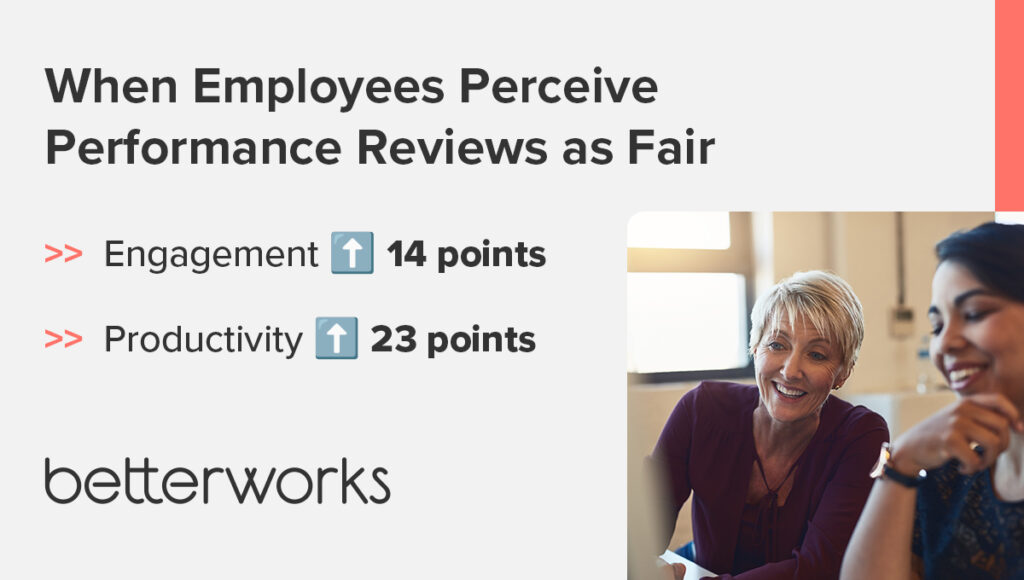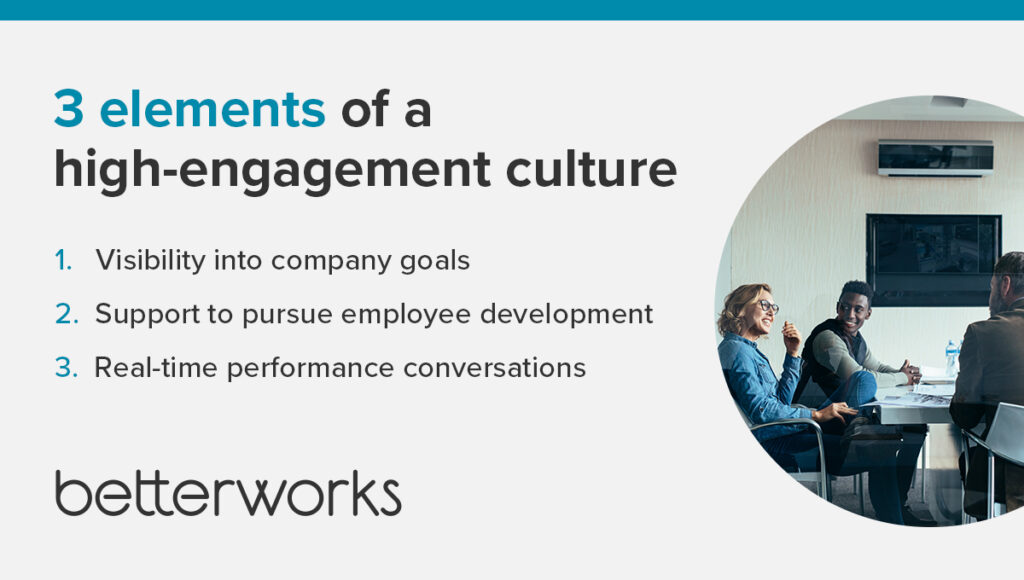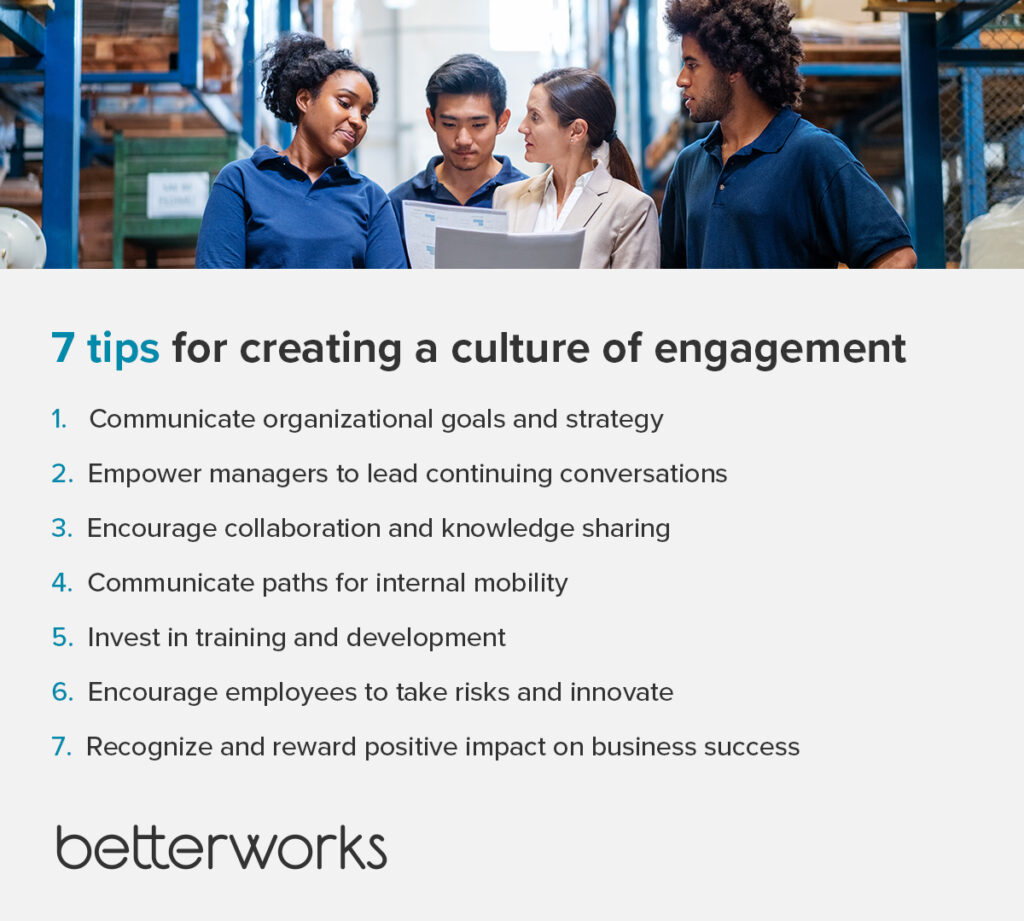- How does a culture of engagement affect employee productivity?
- What role do leaders play in cultivating employee engagement?
- 3 key elements of a high-engagement company culture
- 7 tips for creating a culture of engagement
- Communicate organizational goals and strategy
- Empower managers to lead continuing conversations
- Encourage collaboration and knowledge sharing
- Communicate paths for internal mobility
- Invest in training and development
- Encourage employees to take risks and innovate
- Recognize and reward positive impact on business success
- Your culture is the key to business success
Creating a culture of engagement is a crucial element of long-term business success and growth. Employees in a culture of engagement are deeply connected to their work, feel a sense of purpose, and are motivated to contribute to the organization’s goals. This type of culture reflects high job satisfaction, employee commitment and enthusiasm, and a shared belief in the company’s mission and values.
HR plays a pivotal role in nurturing a culture of engagement. As the custodian of talent management and employee well-being, you have a direct impact on the employee experience. HR policies and processes contribute to the workforce’s sense of trust and fairness, engagement, and support of the organization’s broader objectives.
Learn more about the impact a culture of engagement has on workers, and explore tips for fostering a fair and healthy employee engagement culture.
How does a culture of engagement affect employee productivity?
Engagement and productivity are two important outputs of a healthy organizational culture. When employees feel valued and appreciated, they’re more likely to be motivated and to put in focused effort that leads to greater productivity.
But what does that look like in practice? As our 2023 State of Performance Enablement report states, fairness tops the list of factors employees want in a healthy workplace — especially in performance conversations. When employees perceive performance reviews as fair and equitable, engagement and productivity increase by 14 and 23 points, respectively.
Promoting a fair and healthy culture is a surefire way to foster high-performing, highly engaged employees.

What role do leaders play in cultivating employee engagement?
Leaders play a critical role in cultivating employee engagement. Good leaders create positive and fair work environments in which employees feel empowered, appreciated, and connected to the organization’s mission.
Good leaders embody the values and behaviors they wish to see in their employees. By demonstrating enthusiasm, commitment, and open communication, they illustrate how to contribute to a positive work environment and inspire others to follow suit.
Effective leaders drive engagement by communicating the company’s vision, mission, and objectives in a way that connects with each employee’s sense of purpose. When employees find purpose in their work, they’re more likely to give extra discretionary effort.
Transparent communication, meanwhile, builds trust and allows leaders to address concerns, recognize achievements, and share information effectively. Great leaders encourage open dialogue and listen to feedback across all levels of the organization, including the front lines.
3 key elements of a high-engagement company culture
Creating a high-engagement company culture is vital for organizational success. Here are three elements of employee engagement that promote increased purpose and productivity.
Visibility into company goals
Having visibility into company goals is essential for creating a culture of engagement. When employees understand the organization’s objectives and goals, they can see the purpose in their work. They might even be more motivated to create and witness their impact in real time.
Visibility also helps workers see how their goals overlap with their colleagues’. The result is better communication and collaboration across departments. Visibility into company goals can also encourage a culture of accountability. Employees with clear expectations are more likely to take ownership for their performance, work ethic, and progress. This can increase trust and respect between workers and management, among other benefits.
Support to pursue employee development
When employees are encouraged to pursue their development goals, they’re more likely to stay engaged with their work and the organization. It’s HR’s responsibility to collaborate with managers and employees to create personalized career development plans that help people grow within the organization. When employees are supported in their development goals, they’re more likely to take ownership of their work and strive to achieve excellence — and do so with you rather than another employer.
Real-time performance conversations
Real-time performance conversations help employees understand their job expectations and the progress they’re making. Managers can provide feedback and direction on how to improve performance without delay. Employees, meanwhile, can ask questions about their work, inquire about larger company issues, and provide feedback to help the manager coach their job performance. This type of conversation also allows for recognition and rewards for jobs well done.
HR plays a pivotal role in helping managers learn to align performance conversations with their team members’ individual development goals. Through regular performance discussions, managers can identify opportunities for improvement and growth in the flow of work.

7 tips for creating a culture of engagement
Ready to turn disengaged employees into your strongest and most motivated performers? Apply these cultural engagement examples to drive engagement in your organization.
Communicate organizational goals and strategy
Without visibility into organizational goals and strategies, employees can’t see how their work contributes, nor can they see what their colleagues are doing. HR leaders can coach managers on how to give regular updates on company goals that show employees how their individual work directly contributes. These updates can be communicated through team meetings, emails, one-on-one check-ins, and other channels.
Celebrate achievements along the way that align with the big-picture goals. Managers should use moments of progress to reinforce the connection between individual objectives and overall company performance.
Empower managers to lead continuing conversations
One of HR’s responsibilities is giving managers the skills and training needed to have frequent conversations with their team and with each direct report. Equip managers with the data they need to provide frequent feedback and progress updates. With better communication, timely feedback, and visibility into performance, employees will stay motivated and on track.
Regular communication is also important to ensure that everyone is aware of changes to the organization’s goals and strategies. This kind of change management is its own challenge, requiring frequent and detailed communication.
Encourage collaboration and knowledge sharing
While everyone has individual goals, everyone is working toward the same overall objectives. Knowledge sharing helps employees work more efficiently and build closer relationships.
To promote collaboration, HR can design and implement cross-functional projects and initiatives that bring together employees across departments with the right mix of skills and experience. Don’t make collaboration feel like a punishment; recognize and reward strong teamwork to further motivate employees to engage in knowledge sharing.
As part of long-term workforce planning, HR can also develop mentorship and coaching programs to facilitate knowledge and skills transfer from experienced employees to newer team members.
By consistently reinforcing collaboration and knowledge exchange, HR improves operational performance and contributes to a vibrant, innovative, and learning-oriented organizational culture.
Communicate paths for internal mobility
Internal mobility is a crucial component of retention. When you retain employees, you have a better chance of creating a cohesive culture of engagement. Internal mobility shows workers how they can advance their careers in ways that help the organization grow and thrive.
HR and managers can improve internal mobility by creating job paths and making these options visible to employees. HR teams should have a comprehensive database of employees’ skills and experiences, along with matching job roles within the organization. HR must also make mobility a cultural norm, encouraging managers to help employees grow rather than hoarding talent.
Managers, meanwhile, should use check-ins to not only monitor worker performance but also inquire about their career aspirations. These ongoing conversations help managers identify high-potential employees and assess their suitability for promotions or lateral moves.
Invest in training and development
In a rapidly evolving economy, your employees need training and development opportunities to keep up with the skills their job role demands. Training and development can help increase employee engagement, job satisfaction, and productivity.
Training and development can be self-directed, but HR and managers can offer structured opportunities internally or through third parties. These include classroom training, conferences, online courses, best digital business cards for professional networking, and more.
Encourage employees to take risks and innovate
Innovation requires a culture that encourages employees to think outside the box and share new ideas. Give them autonomy to make meaningful decisions and to take ownership of projects. Encourage open communication and allow employees to share their thoughts and ideas without fear of criticism or judgment.
Innovation is risky and not always successful. Make reasonable failures OK. Meanwhile, celebrate even small successes to show your workforce that taking risks can lead to positive outcomes. Use failed experiments as an opportunity for teams to talk through what went wrong and what they can learn from the experience.
Recognize and reward positive impact on business success
Employee recognition is a crucial component of a culture of engagement. People want to be noticed when they work hard and contribute to success. Recognition boosts motivation, contributes to a positive environment, and motivates employees to continue striving for excellence.
Recognition can be as simple as a thank-you note or more formal, such as awards or bonuses. Strive to give recognition that’s meaningful to each employee. Some employees appreciate public recognition, while others take more meaning from a leader’s words of praise in private.
Recognition and rewards can also intersect with professional development and internal mobility. HR can help managers explore job enrichment, expanded job duties, or specialized professional development for their best workers. Challenging employees to reach new heights can help them feel valued and appreciated while moving closer to their potential.

Your culture is the key to business success
A culture of engagement is good for employee engagement, as well as a powerful driver of business success. When employees feel connected, motivated, and valued, they’re more productive and more effective while continuously improving. Together, we can cultivate a culture of engagement that empowers people to thrive and creates a lasting positive impact in the workplace and beyond.
Want to know more? Learn how to measure employee engagement.


